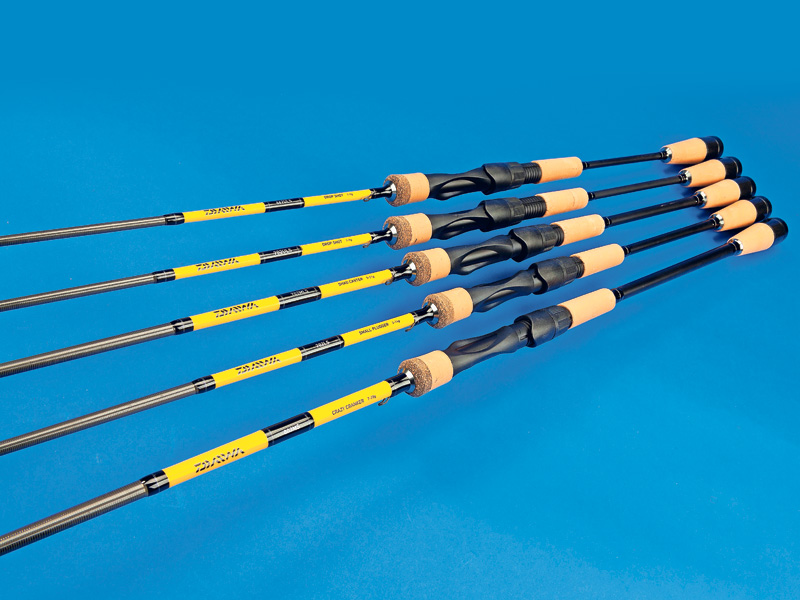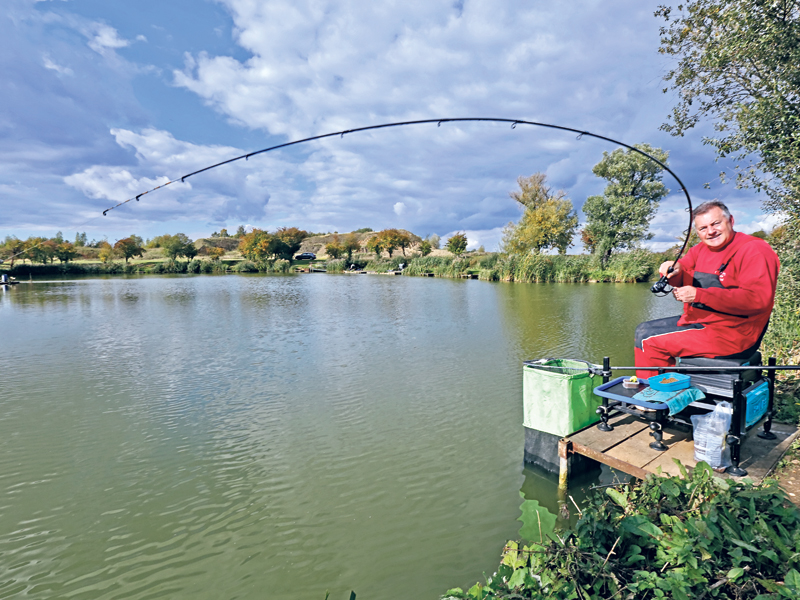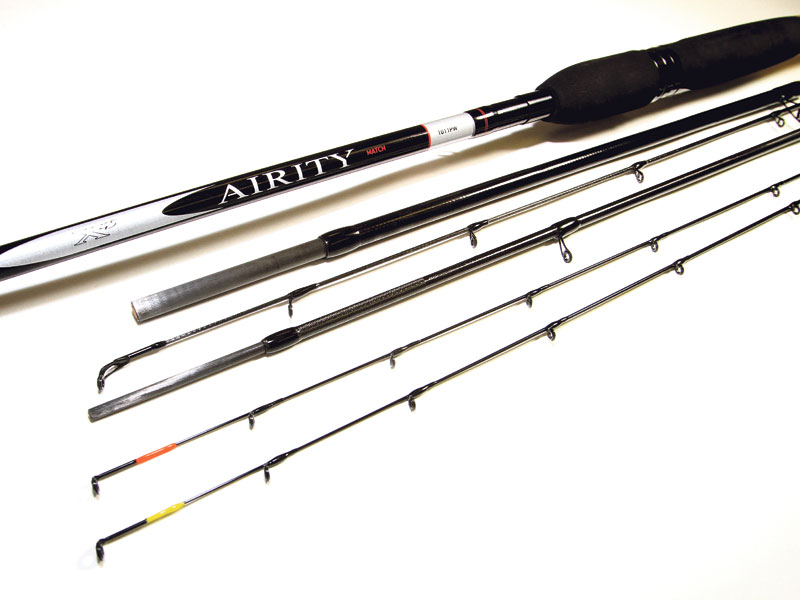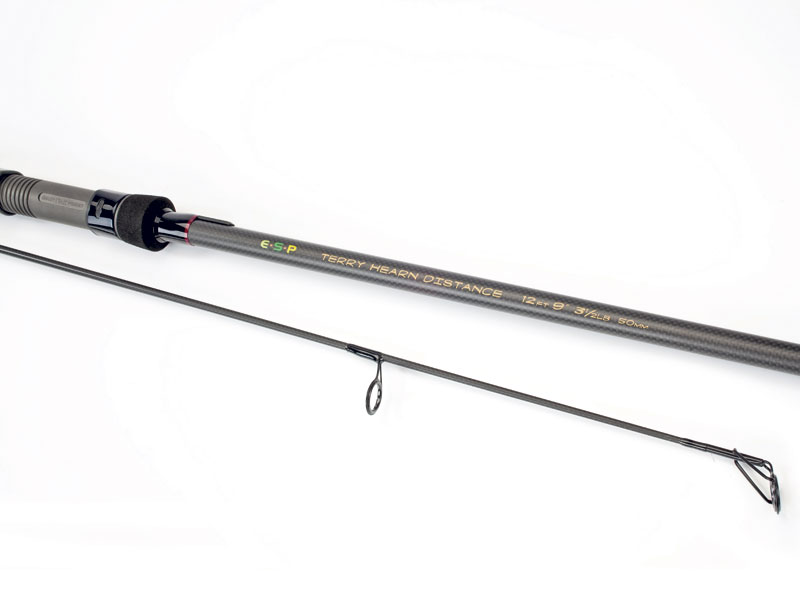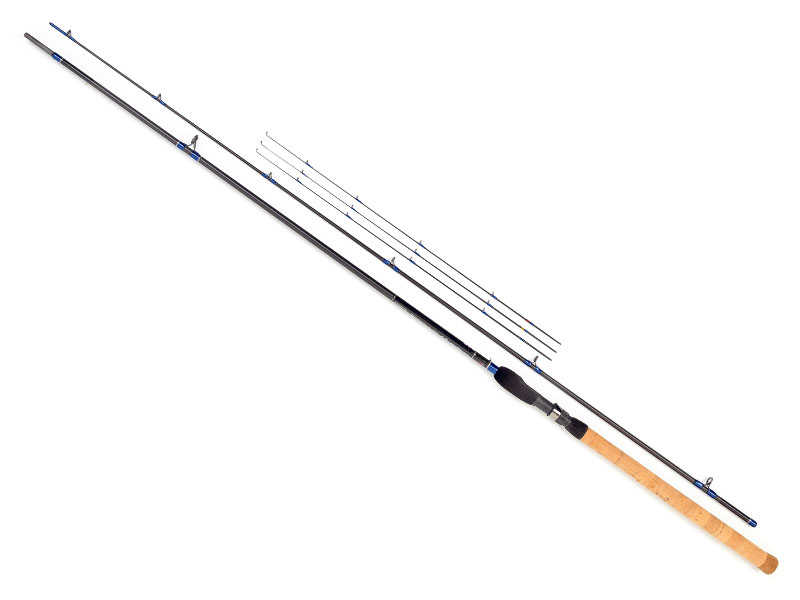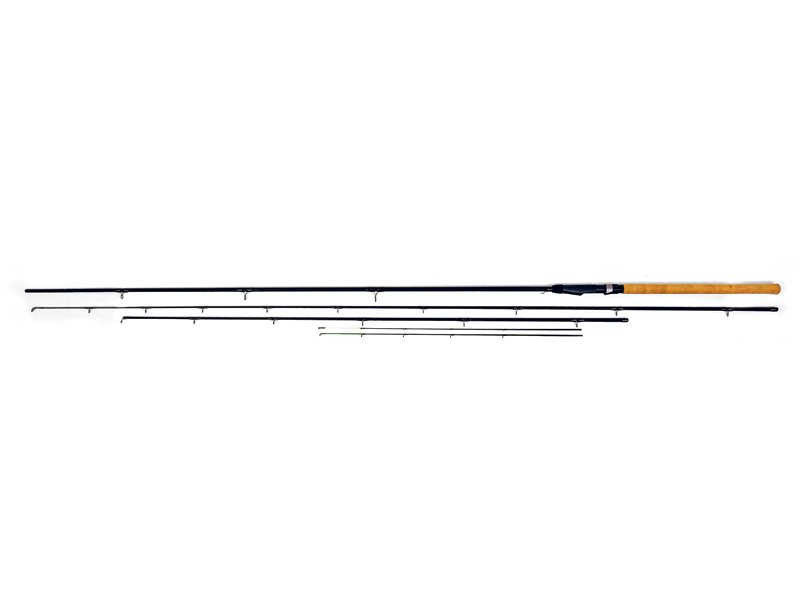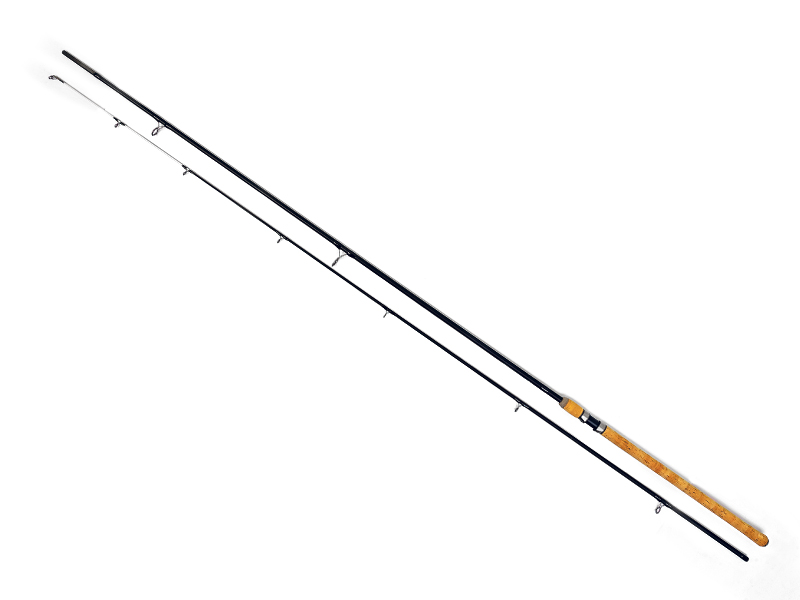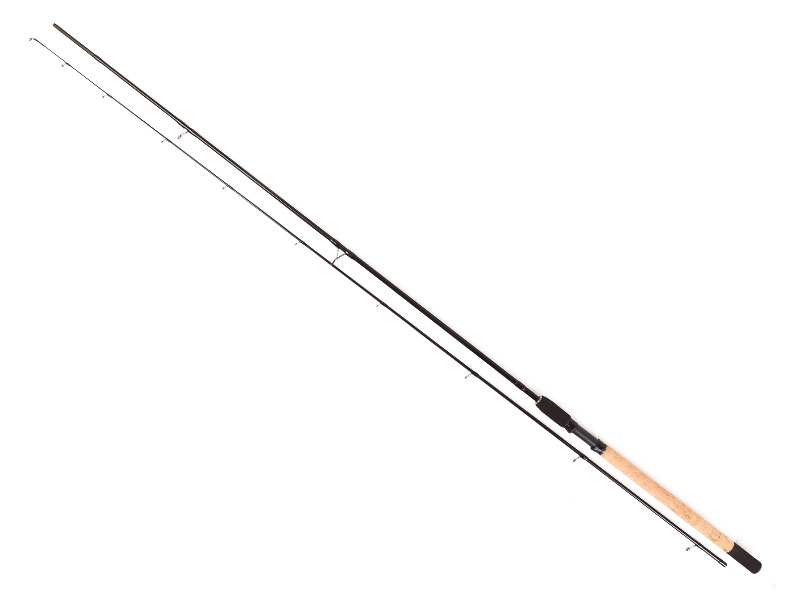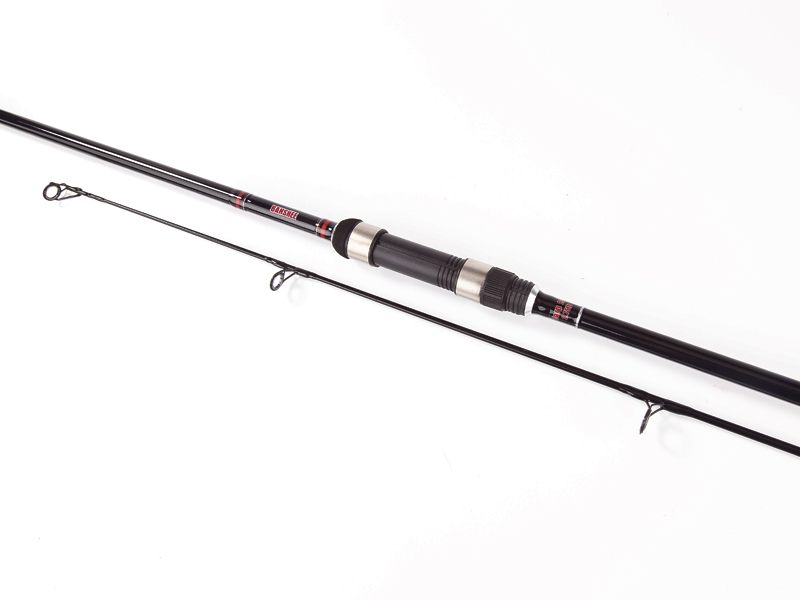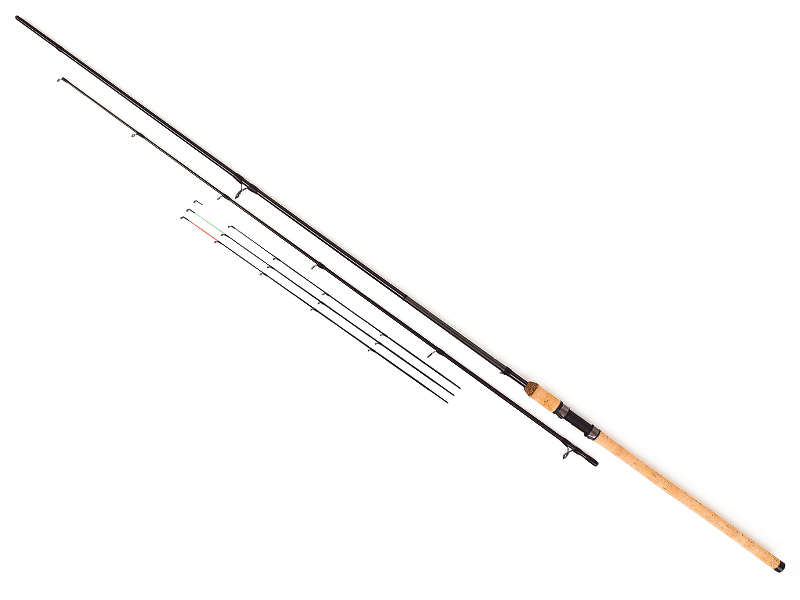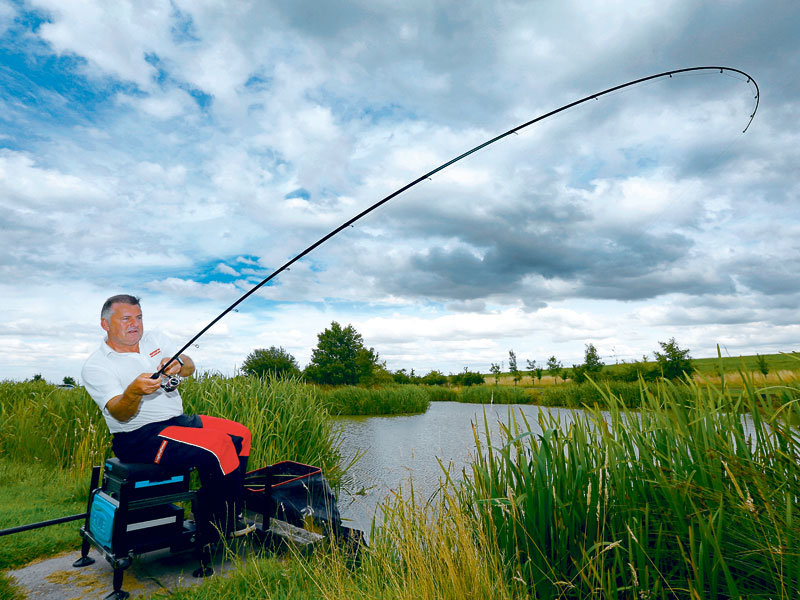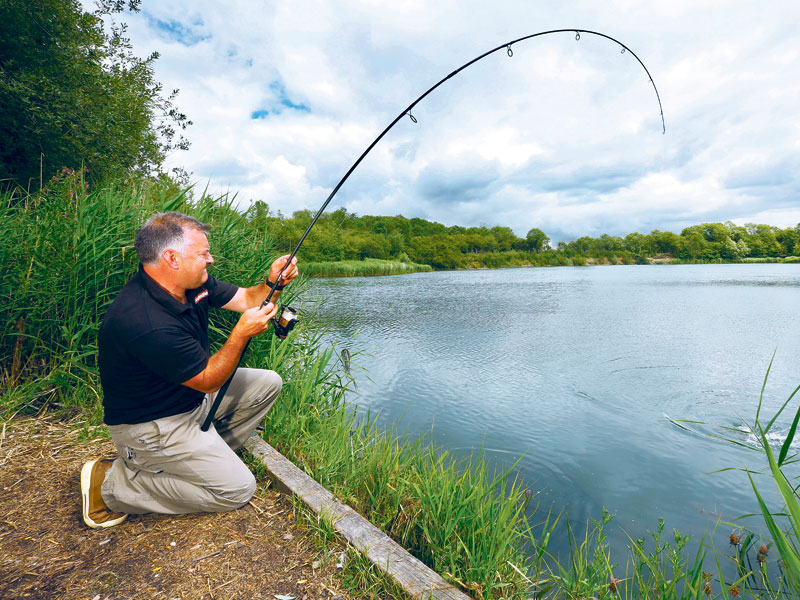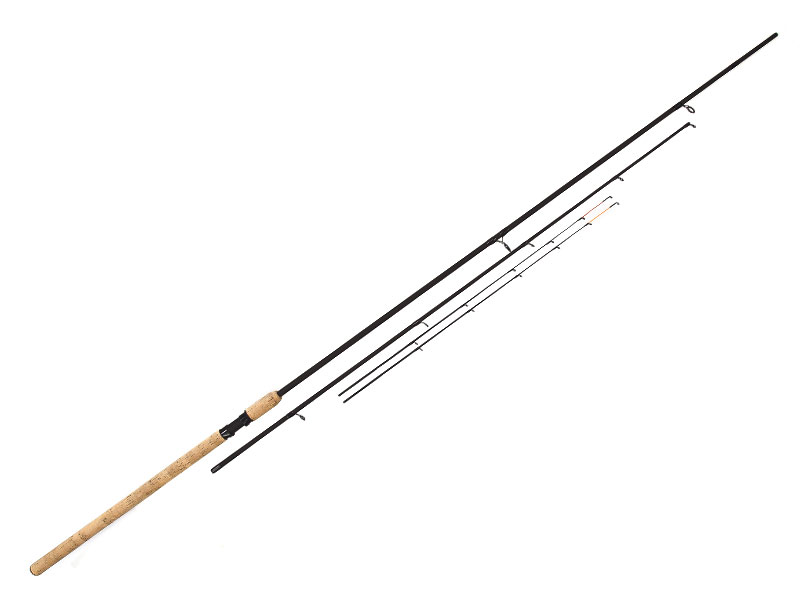Preston Innovations Competition Pro 12ft Medium Feeder rod
PAY AROUND
Preston innovations Competition Pro 12ft Medium Feeder
RRP: £109.99 (but shop around)
PXR Pro 4000 reel
RRP: £104.99 (but shop around)
Not quite as cheap as chips, but more versatile than a Swiss army penknife, is this tasty pair from the Preston stable.
The three-piece 12ft Competition Pro feeder is as much at home dishing it out on rivers as it is battering them down at your local commercial carp venue. The all-carbon blank is nicely put together, and features an old-school full-length 25in cork handle with screw-down reel seat and EVA thumb grip.
Its seamless, flat spot-free progressive action is ideal when targeting big bream, carp, barbel, tench and, of course, chub. The lightweight blank has just about enough softness at its tip to make reel lines of 4lb-8lb with hooklengths down to 0.12mm diameter feasible and, like all good feeder rods, this one has a very high loading point.
This means that when a feeder is attached, the rod only bends from its tip, enabling its backbone to kick in and propel the feeder forward, rather than just lobbing it up and out, as happens when the weight loading area is too far towards the mid-section.
Other features on this Preston rod, which the manufacturers suggest will cast feeders up to 60 metres, are eight low-profile large diameter lined guides. The six equivalent guides on the two spare quivertips also have enlarged diameters, so if you’re off to Ireland, where heavy shockleaders are often used to cushion long casts and protect against zebra mussels, you shouldn’t suffer the annoyance of having the knots catching in the eyes.
The perfect foil for this rod would be its matching Preston branded reel, the award-winning 4000-sized PXR Pro. This model is ideal for winching in heavy feeders and is packed with features including a lightweight aluminium body, quick-release push button spool (plus one spare), precision front drag system, robust stainless steel hollow bail-arm and hard chrome-plated line roller.
Most importantly it runs smoothly and tirelessly on six stainless steel bearings and generates a 4.9:1 gear ratio.
Live testing tackle in winter can be tricky. With the bigger rivers out of sorts, but fed up with bagging commercial carp, where else could I take the Preston pair to prove their mettle? The light-bulb moment eventually came and we were off to Northamptonshire’s River Ise. A stealthy approach using a small cage feeder packed with liquidised bread, and flake on the hook, would hopefully prove successful. The set-up was simple. The reel was loaded with 5lb mainline straight through to a running feeder, stopped with No.8 shot 12in from a size 10 hook. First cast saw the tip tremble, and then it trembled again before pulling round in a classic chub bite. A spirited fight saw a fair sized fish lunging for the nearside reeds, but the 12ft Competition Pro Feeder had a bit too much backbone for any of that old malarkey, and quickly thwarted my quarry’s escape plans.
Through pouring rain, covered in mud, bread and fish slime, both the Preston items performed faultlessly and they get a huge thumbs-up from me.
VERDICT
If there were such a thing as a ‘one-rod does it all’ feeder model, Preston’s Competition Pro Medium Feeder would comfortable pass the test. Every bit as much at home on a commercial carp fishery as it would be bream-bashing on an Irish lough or fishing a big river for barbel, it’s a great all-rounder. As for Preston’s PXR Pro reel, you don’t have to spend long using one to see why the angling public voted it the best reel in its class last year.
Daiwa Harrier Match 13ft rod
PAY AROUND
£54.99
There was a time not so long ago when a three-piece 13ft float rod was standard issue for all match anglers.
Sheffield, Leeds, Rotherham and Birmingham all boasted legions of matchmen whose angling clubs were linked to massive national industries and working men’s clubs. Every weekend would see charabanc outings to the banks of the Witham, Welland, Trent or Severn, where floatfishing was still king and legering came a very poor second.
The best float rods of the day were mainly built on a Golden Jubilee blank, reappearing as WB Clarke’s
All-England, Milbro Enterprise or Billy Lane Match rods.
The first carbon rods weren’t far away, though, and when Fothergill and Harvey’s carbon blank appeared in 1975 they cost a king’s ransom at £133. The early carbon rods, nowhere as good as today’s, cost the equivalent of over £3,000, as much as you’ll pay for a modern flagship pole.
This history lesson earns a place here because 13ft float rods, once the most popular on the market, have evolved tremendously and are available at a steal of a price.
One such model is Daiwa’s 13ft three-piece Harrier Match, which can be found for as little as £44.99.
The rod is built on a decent enough lightweight blank, making it easy and comfy to hold. Its medium-fast action will cast small 3AAA wagglers with no trouble, and it boasts a full cork handle with an EVA lock-down foregrip, lined guides and a matt low-glare finish.
It isn’t the crispest float rod I have ever come across, and it may lack a bit of finesse. But what it can do in spades is handle whatever comes its way – something I was to find out while I was live testing the rod at Boston’s Westwood Lakes.
I had set my stall out for a net of roach and ide, or maybe the odd bream, but the tea-stained Kestrel Lake looked that dirty, I’d have been content to get a bite from anything.
With Storm Imogen racing with unstoppable force across Lincolnshire, this was far from being the best of conditions for floatfishing.
Still, with a 0.10mm hooklength and size 20 red maggot-baited hook on a slow-falling rig, something would surely have a go… wouldn’t it?
It seemed like an age for the bite to come, but eventually it did, and the blaze-coloured float tip sank slowly beneath the surface.
The strike was met by a little more resistance than I had expected, and the rod instantly took on an alarming fighting curve. This action, best described as on the through side of progressive, is pretty much what you want from a float rod if you’re likely to encounter bigger fish.
At first I thought I’d hooked, or even foul-hooked, a carp, hardly what I wanted from a silverfish session, and especially since I was using such lightweight terminal gear.
But as the scrap progressed it became obvious that I had hooked into one of the lake’s legendary barbel.
My balanced tackle was never more welcome than when I slipped the net under a pristine winter Bertram!
The Harrier Match, a long way from being one of Daiwa’s most expensive rods, had absorbed every lunge without my ever breaking sweat that I might get busted up and lose the fish.
Yes, it can be used for small silverfish, but take it from me, the Harrier is capable of an awful lot more when called to battle stations – just like its aircraft namesake, in fact.
VERDICT
On a day when everything but the roach wanted to feed, the Daiwa Harrier proved itself as a great silverfish all-rounder, with enough backbone to cope with much larger quarry when the need arose.
The rod would be well suited to a mixed commercial fishery, where the next bite could come from a matchbox-sized rudd, a powerful carp or, best of all, a belting barbel.
Mark Sawyer
Daiwa Specialist Light Lure Dropshot rods
PAY AROUND
£59.99
Daiwa has added five Light Lure rods to its predator portfolio. The Japanese firm, who can also boast one of the most sought-after light lure rod ranges around in the form of their prestigious Orient-inspired Gekkabijin models, has obviously studied our own lure market carfully before releasing its latest offerings. These rods not only fit the bill perfectly with regard to our drop shot, jig and spin tactics, but they are also sensibly priced at a penny under £60.
The rods offer plenty of scope for the avid lure enthusiast and can be used with light spoons, plugs and shads, as well as the smallest of soft imitations in the case of the two Dropshot models.
These are sure to prove hugely popular, and come in 6ft 6ins or 7ft lengths. Interestingly, they have been designed by Daiwa with identical casting weights from 1g-9g.
If you enjoy working small lures, the Small Plugger rod (3g-14g) should be ideal. The slightly heavier actioned Shad-Caster rod has a 5g-21g rating, while the all-round 8ft Crazy Cranker rod will handle casting weights of between 7g and 28g to cope with larger lures when pike are the main quarry in your sights.
It shouldn’t come as much of a surprise that Daiwa has introduced a small but concise range of rods for our fast-developing lure market.
After all, the global tackle manufacturing giant has acquired and applied more knowledge about developing and constructing short rods for predatory fish than any other company on the planet.
This is a fact that becomes evident within moments of assembling one of the latest Specialist Light Lure Dropshot models.
The ultra-thin two-piece blanks, made frompremium grade carbon, have lightweight single-leg ceramic braid-friendly guides and pleasing cosmetics on a comfy cork split handle.
There’s a tough plastic screw-down hooded reel seat, and a hook-keeper is thrown in for good measure.
However, it isn’t just its stunning build quality that helps this rod to earn a big thumbs-up from me. It also has a very impressive transmission that enables the user to feel every little knock and tremble on the lure, especially, when using a thin braided mainline.
I must also admit that this is the first drop shot rod with a white tip section that I thought was anything more than a needless added extra, and I’ll tell you why. It’s nothing to do with its reflective white colour – something I still don’t see as being necessary.
However, the end of this rod has a seamless flat spot-free 14ins of solid graphite or similar spliced-in tip which has just enough spring, tension and action to help with casting and hook-setting, tempered with exactly the right degree of softness.
This enables you to work a lure with precision and dexterity.
During the live test I was able to tighten up the mainline to a tiny 4g weight without dragging it along the bottom. This, in turn, allowed me to drop the lure on to the bed of the marina while keeping the weight static – a presentation that worked really well for small perch in the cold and dirty water conditions I was faced with.
Like most drop shot rods this one has a progressive fish-playing action, but without the backbone to handle really big critters.
This is not meant as a criticism – let’s face it, 99 per cent of the time it’s perch that fall to drop shot tactics, with anything over 3lb considered a proper specimen.
The rod’s tactile transmission, lightness in the hand and ability to twitch tiny imitations to resemble a tempting snack for a passing stripey are far more important than having enough backbone to bank a big esox. Superb little rods!
VERDICT
These new Daiwa Dropshot rods both come with exactly the same fittings and weight casting ratings of 1g-9g. So the only decision you have to make if you fancy owning one is, which length to go for?
Even then, with only 6ins between them at 6ft 6ins and 7ft, it isn’t really going to affect performance much.
If you do fish water over 6ft deep, though, I would advise the longer model. The action of both is perfect for small lures, giving lots of ‘feel’. They are light and easy to hold for long periods. Pound for pound I would say these are the best bespoke drop shot rods on the market right now.
Browning Sphere 10ft Bomb rod
TECH SPEC
Length: 3m (9ft 10ins)
Sections: 2
Max recommended casting weight: 50g
Spare quivertips: 0.5oz, 0.75oz, 1oz, 1.5oz.
Weight: 133g
PAY AROUND
£249.95
Those who regularly read my tackle review pages will be aware that I have been raving about Browning's top-of-the-range Sphere Feeder rods since first clapping eyes on them a year ago.
I adored them at first sight, and was bowled over by their lively, springy and steely feel and seamless non-locking parabolic curves. Live-testing them has proved to be nothing short of stupendous. They have casting power to burn, with recoil-less rigidity matched with a high weight loading area that will propel a feeder or lead a very long distance, even in the hands of a 'standard' distance casting angler like myself.
But - and here's the best bit - somehow the technical boffins at Browning have been able to produce blanks which blend all of that sizzle-factor with an almost imperceptible finesse which only comes into play when you hook a fish. Clever eh?
Faults are hard to find, other than the weight of their price tags, but they are right up there among the best.
Plaudits aside, there was one model left in the Sphere range that I had been waiting patiently to live-test, until the leaves started falling from the trees.
In the comfort of Browning's showroom, this rod felt ideal as a cold-water commercial-fishery tool, ideal for targeting F1s using light lines and small hooks, as well as being able to cope with the odd bigger fish. So as I tackled up on Decoy's unit-packed Beastie Lake, I was hoping for a live test encounter which would live up to my ambitious expectations.
I wasn't disappointed. The first thing you notice is that the blank has a long butt section at 5ft 2ins and a short a (3ft 4ins) carrier section, although when one of its four 23ins glass quivertips are fitted the two sections become equal length, making it easy to carry around as a ready-made.
Browning rates the rod as optimised at around 30m casting distance, which for me was under-gunning its true potential somewhat. My chosen peg was opposite an island end with a paddle type aerator as an added feature. My guess would have been it was around at least a 50m chuck, well above the rod¹s rating, and made even more difficult by the somewhat less than streamlined shape of the 20g pellet feeder I had tied on.
Not a problem! I even had to feather the line a little to avoid an overcast, and once clipped the rod hit the distance every time without fail. All very impressive, but not as impressive as what went on over the course of the next few hours. It¹s called Beastie Lake for a very good reason. Barbel, carp and F1s all grow fat healthy in this fabulous lake, and the Sphere handled them all with consummate ease, even when I had a dabble down the margin.
The resident barbel know every root-end and snag, but the rod pulled them away quickly and cleanly without a creak of complaint. I purposely over-loaded the stress-factor by pulling directly from above in an attempt to make the blank rotate, which in turn makes the guides twist out of alignment but they stayed die-straight throughout the ordeal.
I went through the card with this rod - maggot feeders with small hooks and 0.10mm hooklengths, pellet feeders with heavier lines and hair-rigs, straight lead and pellets - it was faultless. It would happily cope with main lines or braids from 4lb to 8lb and will cast up to 30g weights easily enough. Plus, you can use it with light lines and small hooks as its soft action is very forgiving, so hook pulls are kept to a minimum.
The four push-in glass quivertips are rated 0.5oz, 0.75oz, 1oz and 1.5oz which helps to provide it with sensitivity and durability.
Although it carries a bomb rod tag, the Browning Sphere model shouldn¹t be thought of as an old-school whispish wand designed for winkling out silvers from flooded rivers or canals. It¹s a very modern model with the casting backbone and parabolic fish playing action required for nearly all standard commercial fishery feeder and lead work.
The pencil slim blank has a superb transmission and steely feel, perfectly matched with the forgiving softness that is a hallmark of the Sphere range. If you¹re into the commercial fishery scene then you owe it to yourself to have a closer look.
Daiwa Light Lure rods
Pay around
£59.99
This eye-catching new range of rods is designed for all light lure work and can be used with tiny spoons, plugs and soft lures. Incredibly lightweight, and with plenty of feel and transmission, they will make catching every fish a joy. The two drop shot models feature spliced-in solid carbon tips for added sensitivity.
Daiwa Mission DF Carp rods
PAY AROUND
£125.00
The new Mission DF (Danny Fairbrass signature) models perform well above their price tag. With fittings and furnishings implemented to Danny’s specifications, they feature slime shrink tube handles, 50mm butt guides and a low-glare finish, and are available in 2.75lb, 3lb and 3.5lb test curves.
Daiwa Airity Match and Feeder rods
PAY AROUND
£375-£450
Daiwa has used its tried and trusted Tournament blanks to create this new nine-model Airity series. The extra performance of the latest X45 carbon material is said to offer improved torque and power conversion.
The Airity hybrid 10ft/11ft is every bit as much at home casting a pellet waggler as it is a Method feeder, and will be of great interest to commercial matchman. Look out for an exclusive live test here soon.
E-S-P Terry Hearn Distance rod
PAY AROUND
£249.99
As the water starts to lose its colour, carp seek the solace of deeper water or hidden features.
This is when you need a rod that will hit the horizon, and E-S-P’s latest Terry Hearn Distance rod does just that.
The 3.5lb test curve, two-piece 12ft 6ins carbon blank boasts top-end single legged SiC guides throughout – including a 50mm butt guide – a full-length slim EVA handle and a Fuji DPS reel seat with flared collar. In the right hands it will cast accurately over 100 metres
Tri-Cast Trilogy 11ft 6ins Commercial Waggler rod
TECH SPEC
11ft 6ins version
Casting weight: Up to 20g
Line rating: 2lb-6lb
12ft version
Casting weight: Up to 30g
Line rating: 2lb-8lb
PAY AROUND
£179.99
This new two-piece 11ft 6ins Tri-Cast Trilogy Commercial Waggler rod offers the keen match angler something rather different to the usual 10ft, 11ft or 12ft rods of this general type.
It is quite capable of casting pellet wagglers up to 20g, but it can handle lighter straight wagglers from 3AAA upwards just as well.
When you first pick up the rod the pencil-slim carbon blank feels a little too light in the hand, and you could be excused for thinking that it would be best suited to F1s, small carp and big silvers, rather than ‘proper’ carp. However, you would be mistaken – as I was after a few hours of boisterous activity on Cedar Lake at Peterborough’s fish-packed Decoy Lakes.
The latest Tri-Cast model took on and beat everything thrown at it, from double-figure carp to barbel almost as big and twice as aggressive. Yes, this rod really is a wolf in sheep’s clothing.
The progressive action has a wonderful degree of elasticity that enables it to bend almost double when put under heavy stress, but there is no suggestion of twist along the guides. The blank simply soaks up the punishment, and what’s more it’s great fun to fish with.
With its low-profile guides set off by bright blue gloss whippings it’s a bit of looker into the bargain.
VERDICT
Don’t imagine that this new rod is nothing more than another version of Tri-Cast’s famed XRS-2K4 model. The Trilogy Commercial has an altogether different fish-playing and casting action, not to mention looks and feel.
It would also make a better ‘all-rounder’ as its lightness and elasticity make it a very versatile rod indeed.
Mark Sawyer
Tri-Cast 11ft Trilogy Feeder rod
TECH SPEC
8ft version
Casting weight: Up to 20g
Line rating: 2lb-6lb
10ft version
Casting weight: Up to 25g
Line rating: 2lb-6lb
11ft version
Casting weight: Up to 30g
Line rating: 2lb-8lb
PAY AROUND
8ft £145.99
10ft £182.99
11ft £196.99
Who remembers (and probably laments the passing of) Carbotec Fast Play Feeder rods? They were so good that they retain their old face value, or even more for the right model.
This new Trilogy Commercial Feeder shares more than a few of its traits. The two-piece blank is probably a bit lighter and slimmer, and doesn’t have quite the same degree of casting clout, but it still has an extraordinary amount of fish-playing elasticity. There’s not a sign of flat spotting, nor does the rod form anything other than a perfect hoop when put under strain. The more you pressure it, the better it gets.
The casting action has a fair bit of hidden backbone spliced into it, and the 11ft model on test threw a 40g flatbed Method feeder more than 40m with little more than a swish.
The rod comes complete with light, medium and heavy push-in carbon quivertips that do nothing to mar its seamless flat-free fighting curve – very commendable of Tri-Cast.
But why on Earth they didn’t add an inch of blaze-coloured paint to the end of each quiver defeats me. Irritating, but that small detail wouldn’t stop me buying one.
VERDICT
I can’t wait to try the shorter 10ft version of this Tri-Cast rod.
I have a feeling it just might be the ultimate snake lake, small pond F1 and big-fish lead rod.
Meanwhile the 11ft model on test casts straight and well, is light in the hand, and has what seems to be a limitless supply of progressive fish-playing clout – it’s pretty special.
Mark Sawyer
Maver 12ft Barbel Twin Top rod
.
PAY AROUND
£89.99
Looking for something other than an out-and-out casting tool at the right price?
This 12ft two-piece twin-top Maver rod could be right up your street.
The 1.5lb test curve blank offers a progressive action and, when fitted with its quivertip carrier section, tightens up towards the mid-section area, providing plenty of punch where you need it most.
With the Avon top in situ the rod becomes much softer, although the backbone of the pokey butt section is still there. It’s more than useful when used with big top and bottom floats, and copes admirably with touch-legering and freelining tactics.
The graphite hooded reel seat is rock-solid, just what you need when retrieving heavy feeders and leads.
Other notable features include quality double-leg SiC lined guides throughout, two unrated carbon quivertips, and a keeper ring.
VERDICT
This quality piece of kit with a modest price tag is nicely suited to all-round feeder/straight lead tactics on larger rivers such the Severn and Trent.
Its Avon-style top section is just about soft enough for floatfishing, too.
Fox Royale Specialist Barbel rod
.
PAY AROUND
£72
This 2.25lb test curve model in the four-rod Fox Royale Specialist Barbel range is a true powerhouse, perfect for when you need to cast large bolt-rigged feeders, big PVA bags or heavy leads to hold bottom in strong flows. It’s more than capable of taming the biggest fish.
Another plus point comes to light when you’re fishing in flood or high water conditions. More often than not debris will gather around the line, jamming in the guides when you reel in.
However, the large and evenly-spaced SLIK guides used on the Royale Specialist blank go some way to stop this happening.
The rod’s white tip is highly visible in low light levels when you’ve got it set high and pointing skywards.
VERDICT
An out-and-out specialist barbel basher, the commanding 2.25lb Fox Royale is the rod to reach for when faced with heavy flows and weighty leads.
The powerful progressive action is more than capable of stopping the largest fish, but the blank retains enough feel to make catching them a pleasurable experience.
Free Spirit 11ft Barbel Tamer rod
PAY AROUND
£104.99 (1.5lb tc), £119.99 (2lb tc)
This is one of the best small-river barbel rods ever made. The two-piece 11ft blank is very light, and its shorter length makes it easy to manoeuvre in awkward, overgrown swims.
The Free Sprit brand has been synonymous with top-of-the-range carp rods for years. But the company produces classy barbel rods too, and its latest Barbel Tamer, in 1.5lb and 2lb test curves, offers outstanding quality at a very reasonable price.
The high modulus 30 and 40 tonne carbon X-wrapped blanks have a very low resin content, and being twin-tipped, they offer either a traditional Avon-style top or one with a 2.5oz push-in carbon quivertip.
A full-length cork handle, original Fuji DPS 16 reel seat and Free Spirit S-Lite guides all contribute to the rod’s natty looks.
VERDICT
Ideal for straight lead set-ups, freelining and smaller weighted feeders up to 3oz, the blank is wonderfully crisp and generates a seamless, almost through type of fish-playing action on smaller waters.
Browning Commercial King Micro Waggler 9ft rod
PAY AROUND
£49.95
Fish on commercials are in the mood for food. They’ll pounce on virtually any bait, and even the crudest tactics will catch them.
But all too soon, as autumn arrives, everything changes. To succeed in cooler water a polished and more refined style of angling is needed, and you need to think very hard about your fishing to carry on reaping the rewards.
Finer lines, smaller hooks and smaller baits are all part of the equation, but to match the finer end tackle you need a suitable rod– and this is where Browning’s latest Commercial King Micro Waggler puts in an appearance.
With its abbreviated length, this nine-footer is obviously tailor-made for short-range casting on small commercial pools and snake lakes, rather than wide expanses of water.
But don’t let its lack of inches mislead you into thinking it’s probably a bit too short to handle anything weighing more than a couple of pounds.
The super-lightweight (160g) two-piece carbon blank dishes out more than enough clout to cope with the odd beastie or two.
Ideally, though, the Micro Waggler should be paired with a 2500 or 3000 sized reel loaded with a good sinking 4lb mainline, and used in conjunction with wagglers weighing no more than 15g. With such a set-up, the rod would be ideal for all maggot and 4mm-6mm pellet hookbaits with appropriately sized hooks and hooklengths.
The pencil-slim blank has a fabulous action that allows it to bend through most of its top section, with plenty of power feeding in via the middle and butt, just perfect for putting carp and F1s on the float in their place.
When it comes to playing and landing bigger fish on a shorter rod you’ll be pleasantly surprised – the reduced length seems to give you more leverage, and quickly brings them within easy range of the net.
Casting accuracy is good too (leaving aside ‘operator error!’), making it ideal to work with in typical parrot cage swims hemmed in by reeds.
In the right hands it will cast 35 yards-plus but, as you might expect, line pick-up at this distance isn’t the fastest.
This rod is at its brilliant best when presenting a waggler with precision just beyond your pole line.
We tested our sample rod at Decoy Lakes’ very scenic Willows Lake which is jam packed with F1s, with the odd bigger fish to keep them company. These larger carp have seen it all before, and can prove frustratingly difficult to nail. The best way is to feed 4mm pellets little and often – these fetch them up in the water pretty quickly. Then it’s a case of picking out your target, taking aim, and landing the banded bait right in front of the fish. Sooner or later one will turn and swirl on the bait, giving an instant and very often explosive take – exciting stuff. It’s really dobbing with a waggler, and patience and accuracy are key.
Now I can’t vouch for your patience, but I certainly can vouch for the casting accuracy of the Browning Micro Waggler!
VERDICT
This tiny waggler rod may seem a bit of a specialist tool, but when it’s too windy for the long pole it comes into its own. With its unerring casting accuracy it’s also ideal for far-bank snake lake work.
Mark Sawyer
TF Gear Banshee carp rod
PAY AROUND
£59.99
TF Gear’s latest 10ft Banshee carp rod is said to be able to catch carp from just about any type of venue.
In test curves of 2.75lb, 3lb and 3.5lb, the blanks are built from quality carbon fibre and furnished with premium grade silicone-lined guides and screw-down custom DPS 18 reel fittings.
The fish-playing action is progressive, and these rods look as if they are built to take a lot of stick.
Middy Nano-Core XZ65 World Elite 10ft Feeder rod
TECH SPEC
- Three special blank graded carbon push-in quivertips of 0.5oz, 1oz and 1.5oz test curves ensure a flat spot-free action, and make the rod suitable for a multitude of feeder applications.
- The rod comes with an original Middy aluminium hooded reel seat ideal for most reel sizes.
- The super-slim 20ins full cork handle makes the rod comfy to hold even when it’s under stress.
PAY AROUND
£209.99
Middy produces some mighty impressive commercial fishery rods these days – everything from short snake lake models to horizon-hitting beasts.
What’s more, there’s something to suit everyone’s pocket.
At the very pinnacle of Middy’s feeder rod range sits the new 10ft Nano-Core XZ65 World Elite, yours for a jaw-dropping £293.99. But panic not, as it can be found at a more realistic price if you shop around.
That said, it’s still a lot to lay out by anyone’s standards, so what exactly would you be shelling out for?
Well, for starters you get an ultra-slim (just 11mm at the butt section), ridiculously light, two-sectioned carbon fibre blank, the result of the very latest Nano-Core technology. This translates into a rod with lightning-fast reflexes, immense strength and flexibility.
The blank has undergone a unique high-pressure vacuum curing process that forces out any tiny air bubbles, ensuring a consistent performance and a flawless finish.
Other luxury touches include three push-in carbon quivertips rated at 0.5oz, 1oz and 1.5oz, seven ceramic-lined double and single SiC Ultra-Flow guides, and a thin full cork handle furnished with a screw-down reel seat.
Middys claims the rod will cast bombs and feeders up to 50g with mainlines up to 12lb and hooklengths up to 8lb.
So far that’s pretty much standard manufacturers’ marketing speak for a commercial feeder rod of this ilk. But in my humble opinion top-end or flagship models should always have that bit extra, the ‘wow factor’ if you will...
You’re already paying for the classy furnishings, fittings and carbon technology, but without that noticeable edge to the rod’s performance all that counts for nowt – and that applies to all tackle brands, not just Middy.
And so to the live test. A favourite water of mine is the peaceful day-ticket Stretton Lakes, just off the A1 north of Peterborough. The fish here are of an average size, and respond to most open-water tactics – ideal helpmates for tackle testing.
Assembling the rod, you cannot help but be impressed by its pencil-slimness – in fact I found the full cork handle a tad too skinny for my own assortment of butt rests, and would suggest that any prospective buyer should look for a small U-bend abbreviated rear rest of the sort favoured by carp anglers.
The sections are not quite equal in length when the carrier section has a quivertip in place, so you need to be extra careful when you’re putting it away ready made-up, even though the classy Middy padded carry bag is more than long enough for the job.
I was not wholly convinced by its suggested 50g maximum casting weight. For me, the top end of the carrier section has a little too much play, and while there is no denying its impressive post-cast recovery speed, this rod is clearly not of the ‘give it a whack’ breed – face it, if you miscast and take out the top section that’s a very expensive mistake to make.
And there end my criticisms. The fact is, the performance of the 10ft World Elite will have you purring with satisfaction. It has a wondrous amount of torque and feel, with a handling aptitude right up there with the very best.
The immaculate gunmetal grey blank has a phenomenal pick-up speed, and its responsiveness to any size of hooked fish actually takes a bit of getting used to. It’s a bit like stepping straight out of your old family saloon and into a works rally car, but once you adapt to the change it’s all systems go – only you won’t have to strap yourself in!
VERDICT
A genuine high-performance rod for the commercial fishery connoisseur, this top-end Middy model will handle most weights of flatbed feeders and straight leads up to 40g (1.5oz). It is equally at home using a maggot feeder with light lines and small hooks for F1s as it would be targeting much bigger fish with bread discs in winter.
Mark Sawyer
Daiwa Harrier Match Pellet Waggler 11ft
TECH SPEC
Full cork handle
Eva down locking fore grip
Matt low glare finish
Light balanced blank
Medium fast actions
PAY AROUND
£49.99
What could possibly prove to be as popular as Daiwa’s TDR and Yank N Bank rods?
Strong contenders must be the 10ft, 11ft (on test) and 12ft Pellet Waggler rods in the new and very affordable Harrier range.
All eight models are realistically priced to put them within reach of anyone wanting to own a Daiwa rod but not blessed with infinitely deep pockets.
That doesn’t mean that the blanks used in their production are in any way inferior, or have cheap fittings. In fact, judging by the test sample sent in to me at Angling Times it’s as though the company has taken extra care to ensure that these bargain-priced models meet Daiwa’s usual high standards.
They all boast a low-glare matt finish which gives them a nice hand-built look, the full cork handles have reliable locking EVA foregrips, and along the blanks are correctly positioned double and then single-leg lined guides which contribute to a medium-fast, progressive action with no flat spots.
Okay, I wouldn’t bet on them being made from the finest high modulus carbon fibre cloths, but these graphite-built beauties feel light and well balanced, with no wobble and a crisp post-cast recovery.
However good a rod may look, the acid test is how well it performs, and a few hours spent throwing around a variety of pellet waggler and splasher floats confirmed the 11ft Harrier Pellet Waggler’s suitability as a cracking small to medium-sized commercial fishery tool.
It is more than comfortable handling floats from 4g up to 10g and reel lines from 6lb-8lb but it’s – let’s say – just a little too ‘manly’ for anything much lighter in the float department.
The fast tapering two-piece blank generates a surprising amount of power, certainly considerably more than I had seen up until now from a graphite-built rod. It’s not overly pokey, it doesn’t feel in the least like a broom handle, but it’s quite a muscular caster. Don’t be afraid to give it a fair old overhead whack to punch out a float against a headwind.
Fish are dealt with quickly and efficiently too, something I found particularly useful when needing to guide lively 3lb-5lb carp around the tackle-wrecking thick reed beds surrounding Sallow Lake on the day-ticket Homeclose Fishery in Rutland.
If you regularly visit a snaggy venue holding big carp that respond well to float tactics, this could be just the rod you’ve been looking for.
It’s built to take the odd knock and bounce back unscathed, and at a penny under 50 quid it really is a steal.
VERDICT
Daiwa has dressed this rod to look like one costing three times the price. Well suited to bigger commercial fisheries, the blank delivers ample fish-playing power and casting clout, but its carefully crafted carbon and glass construction and fast tapering design prevents it from being overly aggressive.
Mark Sawyer
Free Spirit Surface Creeper 'E' 11ft rod
TECH SPEC
- Perdurable blank finish
- 40T carbon weave
- Free Spirit machine-cut aluminium reel seat ion-plated with a blue-grey finish and with a milled isotope slot available as a build option - please enquire
- S-Lite 3-leg rings
- Fuji DPS reel fitting
- Full EVA handle
- Ring sizes (mm): 30 to 8
- Custom build options
- S-Lite tip ring designed to minimise the chance of tangles (and crack-offs) on the cast.
- The Fuji DPS 18 reel seat is light, ergonomic and totally secure – reel seats don’t get much better than this.
- The test rod came with a full EVA handle, but there are cork and shrink tube options available as well.
PAY AROUND
£109.99
Disappointing summer fishing weather is as British an institution as mother-in-law jokes – and has about as much grounding in fact.
More typically, the sun will put his hat on – and that’s when big carp show an interest in floating baits.
Surface fishing can be thrilling yet frustrating as every single bait (except the one with your hook in it) slips silently under the surface, seemingly drawn inexorably downwards by an unseen magnet.
Tricky and nerve-tingling, fishing with floating baits is stalking at its most primeval level – man pitting his wits against crafty fish that have seen it all before. It can drive you half mad. “Why won’t they take my bait?” you ask a passing moorhen as you strike far too late at yet another half-chance.
But when it all goes right, as it did when I live-tested the two-piece 11ft Free Spirit Surface Creeper ‘E’ on Mitre Pool at Bishops Bowl fishery in Warwickshire, all the earlier frustrations are quickly forgotten.
This specialist floater tool has a soft, sensitive tip suited to small controllers and light nylon hooklengths. It is also more than handy for margin stalking and freelining.
The classy chequered 40 tonne Perdurable (non-scratch) all-carbon blank is typical of the aspirational Free Spirit brand. With understated white graphics on the butt section, a Fuji DPS 18 reel seat and braid-friendly S-Lite guides throughout (starting with a 30mm butt guide), the rod on test had a full EVA handle, although full cork or full shrink tube options are available for a small additional charge.
In action, the Surface Creeper ‘E’ takes the biscuit – as indeed do the carp it snares. No, it doesn’t have the casting clout to belt out a weighty controller 100 yards, but it wasn’t built to do so. However, it will cast smaller floats up to 20g well over 50 yards with ease, making it an ideal choice for medium-sized lakes and pits. Its tippy action will flick out a freelined mixer a fair old way, as long as you’re using light reel line.
The live test went well, and the rod’s L plates were off in no time at all.
Feeding some freebies, then hiding away behind some reeds, gave the carp confidence, and soon one made the error of slurping down a mixer with a hook attached. Quick as you like the Surface Creeper took on its full fighting curve, best described as all-through but with steel running through the mid-section. This gives the soft-tipped blank enough poke to deal with hefty lumps without it feeling overgunned.
Soon a scale-perfectmid-double mirror was laid on the unhooking mat… don’t you just love it when a plan comes together!
VERDICT
What a month for live testing fishing rods it’s been! First came Browning’s awesome new 12ft Sphere Feeder, the ultimate bream rod. Then it was the 11ft Free Spirit, perfect for surface fishing with its soft, forgiving tip that allows it to be used for freelining mixers or controller work. It’s ideal for all but the very largest open-water venues.
Mark Sawyer
Korum 11ft Quiver rod
TECH SPEC
• Line rating: 4-10lb.
• Two piece construction.
• High quality cork handle.
• Screw reel fitting.
• Ideal for feeder work or straight lead.
• Supplied with two quivertips: 1oz & 2oz.
PAY AROUND
£49.99
The rod has a full cork handle and two equal-length sections with a line rating of 4-10lb. There's plenty of power to comfortably launch 2oz feeders when you're targeting fish over the pound mark.
The 1oz and 2oz carbon quivertips are well-matched to the rod with the stiff 2oz tip first choice for using with a Method. The lighter tip would be great on rivers.
If you're the sort of angler who likes to divide his bankside time between rivers, natural lakes, large canals and commercial pools, wouldn’t it be great to have one rod to suit them all?
This super-versatile tool has two equal-length sections and comes with two spare 1oz and 2oz push-in carbon quivers. It really does have a multitude of uses and will turn its full cork handle to anything, from maggot feeder and straight lead fishing on rivers for chub and barbel through to open-ender tench and bream tactics. It’ll also chuck a Method feeder for commercial carp.
Having spent a few hours using the test sample from Korum, I can report that it won’t necessarily lend itself particularly well to finesse feeder tactics using tiny hooks and gossamer hooklengths. So if you’re after a net of roach and skimmers, it sadly won’t fit the bill. However, it is very impressive with fish from 1lb upwards, which is probably why it carries a manufacturer’s line rating of 4lb-10lb, which seems about right to me.
Although this is a rod with multi-venue possibilities, time was somewhat against me for my live-test day so I chose a water containing all sorts of fish, in all sorts of sizes. The picture-postcard day-ticket Stretton Lakes near the A1 in Rutland fitted the bill.
I started the session using a 28g pellet feeder with a banded pellet hookbait, cast tight to an island. This soon caught me a string of stockie carp of 2lb-3lb, which all put a healthy and progressive fish-playing bend in the rod.
Its action is geared towards hard and fast playing power, as opposed to a fancy and forgiving one. But whatever it loses in guile is certainly more than made up for in its casting performance. For an 11ft model it has plenty of poke, can withstand a proper whack, and will easily launch at least 2oz of lead.
The carbon quivertips both work perfectly with the rod, with no sign of flat-spotting or making the blank feel top heavy. I have long been an advocate of using stiff carbon tips for all my Method feeder work and the 2oz tip worked a treat when I switched to a 30g flatbed Method cast towards the far-bank reeds.
Unfortunately for me – and the live test – it was one of those days when the carp were really ‘on the munch’, and despite several hookbait changes the greedy stockies devoured all that was thrown
at them. While emptying it, or as photographer Lloyd Rogers so eloquently put it, ‘hook a duck time’, I pondered as to why it’s never like this in matches…
It also struck me that the Korum rod would be very much at home on snag- strewn small rivers, where the stocks of chub and barbel succumb to straight lead, bread/cheese and meat tactics.
VERDICT
What a great little all-rounder of a rod this is, and it comes with a very reasonable price tag! Ideal for a multitude of legering tactics, it really is every angler’s flexible friend.
Mark Sawyer
Shimano Tribal Velocity rod
PAY AROUND
Full range from £139.99 to £159.99, currently retailing from £64.99 to £79.99
Shimano’s latest offer is one to turn your head. These 12ft, 2.75lb test curve Tribal Velocity rods, which used to retail at up to £149.99, are now just £69.99, or £199.99 for a set of three.
For that you get ultra-slim blanks and Japanese shrink-wrap handles, double-leg guides and anti-wrap tip guides. There’s also a built-in line clip and a ‘rod pod stopper’ to secure the rods on your rests.
A compact Shimano reel seat completes the package.





